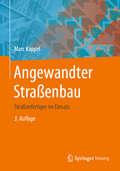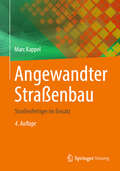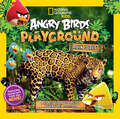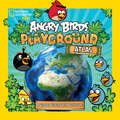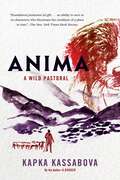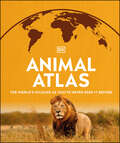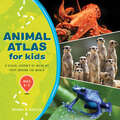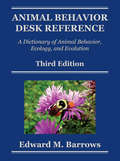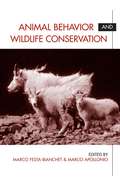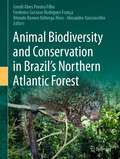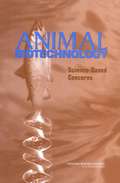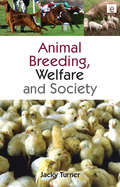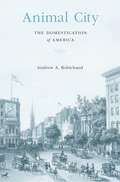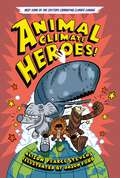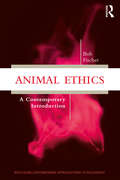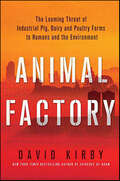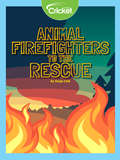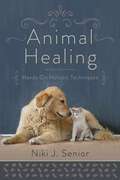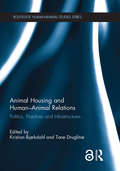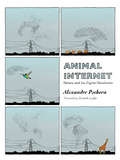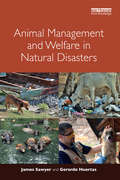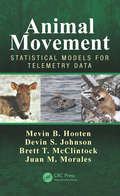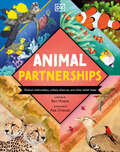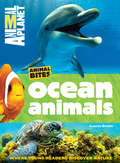- Table View
- List View
Angewandte Meteorologie: Mikrometeorologische Methoden
by Thomas FokenGegenstand des Buchs sind die atmosphärischen Vorgänge im Lebensraum des Menschen. Damit liefert es die Grundlagen insbesondere für die Biometeorologie, Agrarmeteorologie, Hydrometeorologie, Umweltmeteorologie und technische Meteorologie sowie für die Biogeochemie. Der Autor behandelt Theorie, Messtechnik, experimentelle Verfahren und Modellierung so, dass die Themen jeweils für sich stehen und die Inhalte einzeln in Lehre, Forschung und Praxis genutzt werden können. Für die Neuauflage wurden das Literaturverzeichnis und einzelne Kapitel erweitert.
Angewandter Straßenbau: Straßenfertiger im Einsatz
by Marc KappelAnschaulich werden die verschiedenen Verfahrens- und Arbeitstechniken im Straßenbau erklärt. Der Schwerpunkt liegt dabei auf dem Einsatz von Straßenfertigern im Oberbau. Es wird systematisch beschrieben, worauf es bei der Planung und Durchführung eines Straßenbauprojektes ankommt. An elf Beispielbaustellen wird mit handfesten Hinweisen und praktischen Tipps erklärt, wie der Oberbau einer Straße erstellt wird. Es werden zudem die theoretischen Grundlagen vermittelt sowie neueste Erkenntnisse der Forschung und Entwicklung vorgestellt. Dabei stehen vor allem die zunehmende Digitalisierung im Straßenbau, der Einfluss von Industrie 4.0 und BIM im Vordergrund.
Angewandter Straßenbau: Straßenfertiger im Einsatz
by Marc KappelDie vierte Auflage ergänzt das Buch um die neuesten Herausforderungen und Entwicklungen im Straßenbau. Mit einem besonderen Fokus auf Digitalisierung und Automatisierung werden tiefgehende Einblicke in die moderne Baupraxis des Straßenbaus gewährt. Von der historischen Entwicklung bis zu den neuesten Innovationen werden alle relevanten Themen systematisch aufbereitet: der Straßenaufbau, Arten der Asphaltmischungen, der Einsatz von Straßenfertigern und die fortschreitende Digitalisierung im Bauwesen. Besonderes Augenmerk wird auf die praxisnahe Erklärung anhand von beispielhaften Baustellen gelegt, an denen die verschiedenen Themen anschaulich erklärt werden. In einer Branche, in der die intuitive Maschinenbedienung sowie die Nachhaltigkeit an Bedeutung gewinnen, sind die Kapitel zur Automatisierung und Elektromobilität unverzichtbar. Sie beleuchten den Einfluss von Fachkräftemangel, Null-Emissions-Konzepten und temperaturabgesenktem Asphalt auf die Bauindustrie. Mit der Aufnahme eines neuen Kapitels zu den Grundlagen der Straßenplanung wird die Komplexität des Straßenbaus auch vor der Bauausführung beleuchtet. Themen wie Qualitätskontrolle, aktuelle Regelwerke und Arbeitsplatzgrenzwerte für Bitumendämpfe sind ebenso Teil dieser umfassenden Betrachtung wie die Vorstellung neuester Technologien. Das Buch betrachtet zudem die rechtlichen, ökologischen und technologischen Herausforderungen des Straßenbaus – und zeigt, wie eine gute Planung sowie automatisierte Systeme die Branche unterstützen können.
Angry Birds Playground: A Forest Floor to Treetop Adventure
by Jill EsbaumFollow along with your favorite Angry Birds characters as they go on an incredible adventure through the rain forest. Kids will be hooked on a wacky mission to learn all about the rain forest so they can protect it from those bad piggies. Readers analyze and explore the most diverse ecosystem in the world as they build basic skills. Packed with learning exercises and fun activities, Angry Birds Playground: Rain Forest will transform kids into adventurers and leave them wanting more. It's a fun-tastic way to learn about a habitat in danger and the tens of thousands of creatures that call it home!
Angry Birds Playground: A Global Geography Adventure
by Elizabeth CarneyFollow along with your favorite Angry Birds characters as they fly around the world discovering continents, countries, and cultures. Kids will be hooked on a wacky search for the Angry Birds' eggs as they seek out clues that lead them to amazing discoveries. Readers analyze and observe the world from a global perspective as they build basic skills. Packed with learning exercises and fun activities, the Angry Birds Playground: Atlas will transform kids into explorers and leave them wanting more adventure.
Anima: A Wild Pastoral
by Kapka KassabovaIn Anima, Kapka Kassabova introduces us to the “pastiri” people—the shepherds struggling to hold on to an ancient way of life in which humans and animals exist in profound interdependence. Following her three previous books set in the Balkans, and with an increasinging interest in the degraded state of our planet and culture, Kassabova reaches further into the spirit of place than she ever has before. In this extraordinary portrayal of pastoral life, she investigates the heroic efforts to sustain the oldest surviving breeds of our domesticated animals, and she shows us the epic, orchestrated activity of transhumance—the seasonal movement, on foot, of a vast herd of sheep, working in tandem with dogs. She also becomes more and more attuned to the isolation and sacrifices inherent in the lives shaped by this work.Weaving together lyrical writing about place with a sweeping sense of the traumatic histories that have shaped this mountainous region of Bulgaria, Kassabova shows how environmental change and industrial capitalism are endangering older, sustainable ways of living, and by extension she reveals the limited nature of so much of modern life. But shining through Kassabova’s passionate, intimate response to the monoculture that is “Anthropos” is her indelible portrait of a circulating interdependence of people and animals that might point to a healthier way to live.
Animal Atlas (DK Where on Earth? Atlases)
by DKThis stunning new atlas is your first-class pass on a world tour of the homes of Earth's most incredible animals. The latest exciting title in DK's popular Where on Earth? series maps out the habitats of the world's mammals, fish, birds, reptiles, invertebrates, and more. Whether it's plotting the range of a lion, following the flight paths of birds, tracking great white sharks in the oceans, or exploring the migration of the monarch butterfly, you will see exactly where and how more than 100 extraordinary animal species live. What makes Animal Atlas unique are the maps themselves. Each one is individually commissioned in 3-D, with detail to show the habitat of each animal, as well as its geographic location. This reveals an astonishing amount of information about the behavior of these animals, from how seals are adapted to survive in freezing Antarctic seas to how beetles survive in the heat of the Sahara desert. There is also a focus on the conservation and protection of animals. Maps reveal the shrinking territories of some species, showing where they used to roam in the past compared to what's left of their range today. Whichever animal you're trying to track down, you're sure to find it in Animal Atlas.
Animal Atlas for Kids: A Visual Journey of Wildlife from Around the World
by Michael A. DiSpezioDiscover animals on every continent in a worldwide tour for kids ages 6 to 9 Spark children's curiosity and imagination with a whole world of amazing animals! This animal atlas introduces kids to more than 180 animals from all over the globe. They'll explore colorful maps of every continent and ocean and learn all about the creatures that live there. From the smallest insects to the biggest whales, kids can meet each one up close with photos and find out fun facts about their natural environment. Kids will discover animals like: CHIMPANZEE, African Rainforests—Chimpanzees live in trees and grasslands. Like other apes, they are highly intelligent. They also laugh when they're playing! TARANTULA, Central America—Tarantulas are large spiders. They have eight legs like other spiders, but they do not spin webs. Instead, they live in an underground burrow. SIBERIAN CHIPMUNK, Northern Asia—Like all chipmunks, a Siberian chipmunk has stripes along its back. It also has cheek pouches that carry food—kind of like grocery bags! BELUGA WHALE, Arctic Ocean—This white whale produces all sorts of sounds and has a thick layer of fat under its skin, called blubber. Encourage kids' passion for the natural world with this entertaining choice in educational animal books for kids.
Animal Behavior Desk Reference: A Dictionary of Animal Behavior, Ecology, and Evolution, Third Edition
by Edward M. Barrows"Words are our tools, and, as a minimum, we should use clean tools. We should know what we mean and what we do not, and we must forearm ourselves against the traps that language sets us." -- The Need for Precise Terminology, Austin (1957, 7-8) It follows that, for effective and efficient communication, people should have, or at least understand, th
Animal Behavior and Wildlife Conservation
by Marco Apollonio Marco Festa-BianchetEfforts to conserve wildlife populations and preserve biological diversity are often hampered by an inadequate understanding of animal behavior. How do animals react to gaps in forested lands, or to sport hunters? Do individual differences--in age, sex, size, past experience--affect how an animal reacts to a given situation? Differences in individual behavior may determine the success or failure of a conservation initiative, yet they are rarely considered when strategies and policies are developed. Animal Behavior and Wildlife Conservation explores how knowledge of animal behavior may help increase the effectiveness of conservation programs. The book brings together conservation biologists, wildlife managers, and academics from around the world to examine the importance of general principles, the role played by specific characteristics of different species, and the importance of considering the behavior of individuals and the strategies they adopt to maximize fitness.Each chapter begins by looking at the theoretical foundations of a topic, and follows with an exploration of its practical implications. A concluding chapter considers possible future contributions of research in animal behavior to wildlife conservation.
Animal Biodiversity and Conservation in Brazil's Northern Atlantic Forest
by Rômulo Romeu Nóbrega Alves Gentil Alves Pereira Filho Frederico Gustavo Rodrigues França Alexandre VasconcellosThis book describes the fauna of the Pernambuco Endemism Center in Brazil's Northern Atlantic Forest, an understudied global biodiversity hotspot. Through fifteen curated chapters, it provides the latest information about the fauna of the northern portion of the Atlantic Forest, gathering important information about the faunal composition of the region for the first time. The chapters address animal biodiversity including terrestrial and aquatic vertebrates (fish, amphibians, reptiles, birds, and mammals) and invertebrates (ants, butterflies, dung beetles, hervestmen, spiders, and termites). All chapters provide species lists, taxonomic aspects and richness analysis. Conservation of specific animal groups is also discussed. Finally, the book discusses human impacts on the forest and its biodiversity, emphasizing the need for conservation of this highly impacted ecosystem.
Animal Biotechnology: Science-based Concerns
by National Research CouncilGenetic-based animal biotechnology has produced new food and pharmaceutical products and promises many more advances to benefit humankind. These exciting prospects are accompanied by considerable unease, however, about matters such as safety and ethics. This book identifies science-based and policy-related concerns about animal biotechnology—key issues that must be resolved before the new breakthroughs can reach their potential.The book includes a short history of the field and provides understandable definitions of terms like cloning. Looking at technologies on the near horizon, the authors discuss what we know and what we fear about their effects—the inadvertent release of dangerous microorganisms, the safety of products derived from biotechnology, the impact of genetically engineered animals on their environment. In addition to these concerns, the book explores animal welfare concerns, and our societal and institutional capacity to manage and regulate the technology and its products. This accessible volume will be important to everyone interested in the implications of the use of animal biotechnology.
Animal Breeding, Welfare and Society
by Jacky TurnerThe determination of when, how, how often and with whom an animal breeds is moving rapidly away from evolutionary pressures and towards human purposes: these include the breeding of around 50 billion mammals and birds for food production annually, the breeding of pedigree dogs and cats, racing dogs and horses, specialised laboratory animal strains and the use of reproductive science to conserve endangered species or breeds and to limit unwanted populations of pests and non-native species. But the ethics and sustainability of this takeover of animals' reproductive lives have been insufficiently examined by either professionals or the public. This book discusses the methods, the motivations and the consequences of human intervention in animal breeding in terms of animal health, behaviour and well-being. It explores where we are now and the choices ahead, and looks to a future where we have more respect for animals as sentient beings and where we could loosen the reins of reproductive control.
Animal City: The Domestication of America
by Andrew A. RobichaudAmerican urbanites once lived alongside livestock and beasts of burden. But as cities grew, human–animal relationships changed. The city became a place for pets, not slaughterhouses or working animals. Andrew Robichaud traces the far-reaching consequences of this shift—for urban landscapes, animal- and child-welfare laws, and environmental justice.
Animal Climate Heroes
by Alison Pearce StevensIn our left corner we have the meanest villain that’s ever existed. Responsible for rising seas and loss of biodiversity, it’s climate change ready to wreak havoc on the Earth. But in our right corner? We have four superheroes ready to save the day!Forest elephants protect our forests by trampling trees.Whales boost ocean health with their massive poo-nados.Sea otters defend kelp forests from purple invaders.And echidnas bury tons of soil to stop climate change.But we can’t leave them in this fight alone. We need to protect our heroes who, in return, defend our planet. Get ready to learn all about these four legged, and two-flippered, creatures and how YOU can be a climate hero too!
Animal Ethics: A Contemporary Introduction (Routledge Contemporary Introductions to Philosophy)
by Bob FischerThere are many introductions to the animal ethics literature. There aren’t many introductions to the practice of doing animal ethics. Bob Fischer’s Animal Ethics: A Contemporary Introduction fills that gap, offering an accessible model of how animal ethics can be done today. The book takes up classic issues, such as the ethics of eating meat and experimenting on animals, but tackles them in an empirically informed and nuanced way. It also covers a range of relatively neglected issues in animal ethics, such as the possibility of insect sentience and the ethics of dealing with pests. Finally, the book doesn’t assess every current practice using standard ethical theories, but tries to evaluate some of them using the moral frameworks endorsed by those involved. So, for instance, there is a chapter on the way that animal care and use committees try to justify some of the educational uses of animals, and the chapter on zoos considers the way that international zoological societies justify compromising animal welfare. The book wraps up with a discussion of the future of animal ethics. Each chapter opens with a helpful initial overview of the chapter and ends with a list of suggested readings to help students go further on their own. Key Features Covers animal ethics from an empirically informed perspective, bringing philosophy into conversation with key issues in animal science, conservation biology, economics, ethology, and legal studies, among other fields Provides ample coverage of the most salient current topics, including, for example: Debates about which animals are sentient The suffering of wild animals Research ethics The boundaries of activism Avoids suggesting that animal ethics is simply the practice of applying the right general theory to a problem, instead allowing readers to first work out the specific costs and benefits of making ethical decisions Impresses upon the reader the need for her to work out for herself the best way forward with difficult ethical issues, suggesting that progress can indeed be made Includes summaries and recommended readings at the end of each chapter
Animal Factory: The Looming Threat of Industrial Pig, Dairy, and Poultry Farms to Humans and the Environment
by David KirbySwine flu. Bird flu. Unusual concentrations of cancer and other diseases. Massive fish kills from flesh-eating parasites. Recalls of meats, vegetables, and fruits because of deadly E-coli bacterial contamination. Recent public health crises raise urgent questions about how our animal-derived food is raised and brought to market. In Animal Factory, bestselling investigative journalist David Kirby exposes the powerful business and political interests behind large-scale factory farms, and tracks the far-reaching fallout that contaminates our air, land, water, and food. In this thoroughly researched book, Kirby follows three families and communities whose lives are utterly changed by immense neighboring animal farms. These farms (known as "Concentrated Animal Feeding Operations," or CAFOs), confine thousands of pigs, dairy cattle, and poultry in small spaces, often under horrifying conditions, and generate enormous volumes of fecal and biological waste as well as other toxins. Weaving science, politics, law, big business, and everyday life, Kirby accompanies these families in their struggles against animal factories. A North Carolina fisherman takes on pig farms upstream to preserve his river, his family's life, and his home. A mother in a small Illinois town pushes back against an outsized dairy farm and its devastating impact. And a Washington State grandmother becomes an unlikely activist when her home is invaded by foul odors and her water supply is compromised by runoff from leaking lagoons of cattle waste. Animal Factory is an important book about our American food system gone terribly wrong---and the people who are fighting to restore sustainable farming practices and save our limited natural resources.
Animal Firefighters to the Rescue
by Sonja ColeClimate change affects many regions with hotter and drier weather, and forest fires are a growing problem. Learn how hungry animals might help reduce wildfires. Fires need fuel, oxygen and heat to start a flame. The forest floors are covered with dry grass, dead wood, and bark called duff–fire fuel! Learn how conservationists are using sheep, goats, beavers and other animals to reduce fires!
Animal Healing: Hands-On Holistic Techniques
by Niki J. SeniorUse Powerful Natural Techniques to Heal and Communicate with Your AnimalsEnhance the health and happiness of your beloved companions with this comprehensive guide to holistic healing and therapy modalities. Animal Healing demystifies vibrational energy and offers detailed information on how you can sense, establish, and attune your awareness to animal energy. You'll learn to activate wellness on all levels and deepen the unbreakable bond with your animal's heart, mind, and soul.Providing in-depth descriptions and case studies that illustrate the healing modalities, Niki J. Senior sheds light on the true nature of animal health and disease. Through ground-breaking methods and exercises, she helps you use gemstones, crystals, flower essences, and other natural remedies to effectively heal your animal.Praise:"As a professional vet, I found this book an enlightening approach to holistic animal health and understand how complementary and veterinary methods can work in synergy."—Bernd Wittorf, MRCVS, veterinarian, Freie Universität Berlin"[Animal Healing includes] a combination of anecdotes, success stories, personal battles, science, therapies, how-to instruction, and self-care . . . by the time you have finished, your love for your animal, yourself, and for all of life will have reached new vibrations, new connections, and higher energies—you will already be healing your animal before you know it!"—Isla Fishburn, PhD, founder of Kachina Canine
Animal Housing and Human-Animal Relations: Politics, Practices and Infrastructures (Routledge Human-Animal Studies Series)
by Kristian Bjørkdahl Tone DruglitrøThis book provides an in-depth investigation into the practices of animal housing systems with international contributions from across the humanities and social sciences. By attending to a range of different sites such as the zoo, the laboratory, the farm and the animal shelter, to name a few, the book explores material technologies from the perspective that these are integrated parts of a larger biopolitical infrastructure and questions how animal housing systems, and the physical infrastructures that surround central human-animal practices, come into being. The contributions in the book show in various ways how physical infrastructures of animal housing are always part of a much broader sociocultural and political infrastructure, where the material reality of housing systems combines with human and animal agents, with politics, and with practices. As such, the book explores what kind of practices and relations develop around the physical structures of animal housing, and by whom, and for whom, they are developed. This innovative collection will be of great interest to student and scholars in animal studies, more than human studies, geography, anthropology, and sociology.
Animal Internet: Nature and the Digital Revolution
by Alexander Pschera Elisabeth Lauffer"Animal Internet is a most important book. This excellent work could be a strong catalyst for people to rewild, to reconnect and become re-enchanted with all sorts of mysterious and fascinating animals, both local and distant. By shrinking the world it will bring humans and other animals together in a multitude of ways that only a few years ago were unimaginable."--Marc Bekoff, University of Colorado, author of Rewilding Our Hearts: Building Pathways of Compassion and Coexistence "An original book that goes against the trend to stubbornly keep nature and technology divided from one another."--Der Spiegel "Animal Internet is one of the most interesting books that I've read in recent years."--Bavarian Radio"What Pschera describes sounds futuristic but it's already widespread reality . . . Pschera's book is not just popular science: he describes not only the status quo, but also thinks about an ongoing transformation."--Wired.deSome fifty thousand creatures around the globe--including whales, leopards, flamingoes, bats, and snails--are being equipped with digital tracking devices. The data gathered and studied by major scientific institutes about their behavior will warn us about tsunamis, earthquakes and volcanic eruptions, but also radically transform our relationship to the natural world. With a broad cultural and historical perspective, this book examines human ties with animals, from domestic pets to the soaring popularity of bird watching and kitten images on the web. Will millennia of exploration soon be reduced to experiencing wilderness via smartphone? Contrary to pessimistic fears, author Alexander Pschera sees the Internet as creating a historic opportunity for a new dialogue between man and nature.Foreword by Martin Wikelski, Director, Max Planck Institute for OrnithologyAlexander Pschera, born in 1964, has published several books on the internet and media. He studied German, music, and philosophy at Heidelberg University. He lives near Munich where he writes for the German magazine Cicero as well as for German radio.
Animal Management and Welfare in Natural Disasters
by James Sawyer Gerardo HuertasThe devastating impacts of natural disasters not only directly affect humans and infrastructure, but also animals, which may be crucial to the livelihoods of many people. This book considers the needs of animals in the aftermath of disasters and explains the importance of looking to their welfare in extreme events. The authors explore how animals are affected by specific disaster types, what their emergency and subsequent welfare needs are and the appropriate interventions. They describe the key benefits of management of animals to populations and discuss preventative measures that can be taken to reduce risk and build resilience. They also include a summary of recent debates and public policy advances on animals in disasters. The book covers livestock, companion and wild animals, with case studies to show how the concepts can be put into practice. It provides a standalone text for students of disaster studies and management as well as professionals and NGOs who require an entry-level introduction to the subject.
Animal Movement: Statistical Models for Telemetry Data
by Juan M. Morales Mevin B. Hooten Devin S. Johnson Brett T. McClintockThe study of animal movement has always been a key element in ecological science, because it is inherently linked to critical processes that scale from individuals to populations and communities to ecosystems. Rapid improvements in biotelemetry data collection and processing technology have given rise to a variety of statistical methods for characterizing animal movement. The book serves as a comprehensive reference for the types of statistical models used to study individual-based animal movement. Animal Movement is an essential reference for wildlife biologists, quantitative ecologists, and statisticians who seek a deeper understanding of modern animal movement models. A wide variety of modeling approaches are reconciled in the book using a consistent notation. Models are organized into groups based on how they treat the underlying spatio-temporal process of movement. Connections among approaches are highlighted to allow the reader to form a broader view of animal movement analysis and its associations with traditional spatial and temporal statistical modeling. After an initial overview examining the role that animal movement plays in ecology, a primer on spatial and temporal statistics provides a solid foundation for the remainder of the book. Each subsequent chapter outlines a fundamental type of statistical model utilized in the contemporary analysis of telemetry data for animal movement inference. Descriptions begin with basic traditional forms and sequentially build up to general classes of models in each category. Important background and technical details for each class of model are provided, including spatial point process models, discrete-time dynamic models, and continuous-time stochastic process models. The book also covers the essential elements for how to accommodate multiple sources of uncertainty, such as location error and latent behavior states. In addition to thorough descriptions of animal movement models, differences and connections are also emphasized to provide a broader perspective of approaches.
Animal Partnerships: Radical Relationships, Unlikely Alliances, and Other Animal Teams (Wonders of Wildlife )
by Ben HoareDiscover a whole host of partnerships from across the animal kingdom, with the nature enthusiast and best-selling author Ben Hoare.Get acquainted with unexpected animal teams around the world, and find out how these groups thrive in the wild as they defend, feed, and plot with each other in order to survive in this fascinating and unique look at animals.Presenting these unpredictable discoveries, Ben Hoare's friendly, informative explanations are paired with striking photographs and colorful illustrations to make sure every page captivates the imagination. This unique animal book for children offers: Groundbreaking scientific discoveries, including animal behaviors that have only just been documented.Impressive facts about previously unknown animal behaviors that are guaranteed to wow adults and children alike.Animals shown in incredible detail through photographs paired with charming illustration.Animal Partnerships explores cooperative relationships between sea turtles at underwater "cleaning stations" ran by surgeon fish, “bands of brothers” within particular species of big cats, and even cross-species alliances between birds and dolphins that are hungry for a shared meal. Discover how animals and plants depend upon each other to hold their territory, and how even humans have come to develop partnerships with animals all around the world.
Animal Planet Ocean Animals (Animal Bites Series)
by Laaren Brown Animal PlanetWith more than 200 gorgeous animal photos of sharks, whales, clown fish, jelly fish, dolphins, and others, Animal Planet Ocean Animals is a fun, habitat-by-habitat guide that provides kids in the first years of schooling with the perfect bite-sized view of their favorite ocean-dwelling animals. Arranged thematically with focus on animal behavior and family relationships, young readers will explore sections about animal bodies, baby animals, food, play time, conservation and more. Special book features designed for this age group include Quick Bites sidebars with cool animal facts, simple infographics, and illustrated maps of Earth's watery environments.For more Animal Bites books, check out Animal Planet Polar Animals!A portion of the proceeds will benefit Animal Planet's R.O.A.R. (Reach Out. Act. Respond.) project which partners with leading animal organization to make the world a better place for domestic and wild animals.

